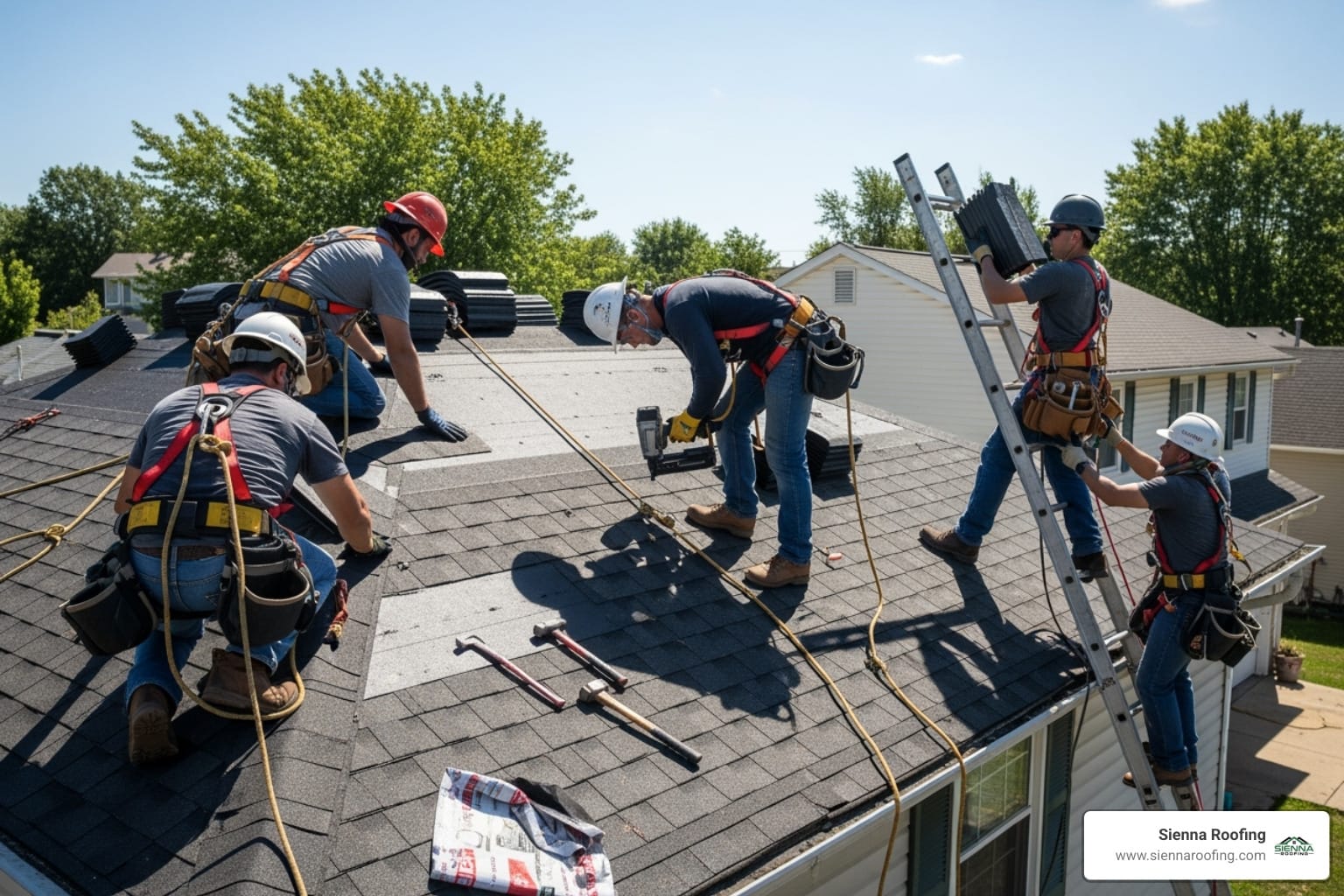Roof Installation Cost 2025: Save Smart
Why Understanding Roof Installation Costs Matters for Your Home Investment
The roof installation cost for a typical home ranges from $5,400 to $19,800, with most homeowners spending around $11,000 for a complete replacement. Understanding these costs is crucial for making smart decisions about one of your biggest home investments. This article is a helpful guide to your new roof and the expenses involved.
Quick Cost Breakdown:
- Asphalt shingles: $3.40-$8.75 per square foot
- Metal roofing: $6.00-$35.00 per square foot
- Labor costs: ~60% of total project cost
- Average timeline: 1-3 days for most homes
- Return on investment: Up to 56.9% for asphalt shingles
Your roof is your home’s first line of defense against Texas weather. From intense summer heat to sudden hailstorms, Sugar Land homeowners know that roofing problems can quickly become expensive headaches. Knowing what factors drive pricing helps you budget properly and avoid surprises, whether you’re dealing with storm damage or an aging roof. The right information makes all the difference when planning your project and choosing professional roofing services.
I’m Andre Castro, CEO of Sienna Roofing. With a background in construction management, I’ve helped hundreds of homeowners in the Houston Metro area steer roof installation cost decisions, ensuring they receive accurate estimates and quality results.

The National Picture: Average Roof Replacement Costs in 2025
When planning a roof replacement, understanding the roof installation cost landscape helps you budget effectively. For 2025, the national average is $11,000, but most homeowners spend between $5,400 and $19,800. The final price depends on factors like materials, size, and complexity.

The cost per square foot typically ranges from $6.30 to $12.30. However, a simple ranch home will cost less per square foot than a complex Victorian with steep angles. Geography also plays a role, as labor costs and building codes vary by location.
How much does a new roof cost?
While the $11,000 national average is a good starting point, Texas homeowners often see costs from $6,200 to $20,400. Regional factors like labor rates, material shipping, and our unique weather challenges influence the final bill. For more details, see our guide on the Average Cost of a New Roof in Texas.
Here’s a breakdown of average costs by square footage for asphalt shingles:
| Roof Size (sq ft) | Average Cost (Asphalt Shingles) |
|---|---|
| 1,000 | $5,573 |
| 1,500 | $7,158 |
| 2,000 | $7,283 |
| 2,500 | $7,686 |
The cost per square foot often decreases on larger roofs because fixed costs like permits and setup are spread over more area.
Breaking down the roof installation cost by material
Your choice of material is a major budget factor.
- Asphalt shingles: The most popular choice, costing $3.40 to $8.75 per square foot and lasting 15-30 years. They come in several varieties. 3-tab shingles are the most affordable, with a flat, uniform appearance, but have a shorter lifespan. Architectural or dimensional shingles are the most common choice today, featuring a thicker, multi-layered design that creates a richer, textured look mimicking wood shakes. They offer better durability and wind resistance. Luxury shingles are the high-end option, designed to replicate the appearance of slate or cedar shakes at a fraction of the cost, offering maximum durability and aesthetic appeal.
- Metal roofing: A higher upfront cost at $6 to $35 per square foot, but it lasts 50-75 years. Metal roofs are highly durable, fire-resistant, and energy-efficient. The most common types are standing seam, which features concealed fasteners for a sleek, modern look and superior weather resistance, and exposed fastener panels (like R-panel or corrugated), which are more economical but require periodic maintenance of the screw gaskets.
- Tile roofing: Offers a classic look for $11 to $25 per square foot with a 50-100 year lifespan.
- Wood shakes: Provide natural beauty for $6 to $14 per square foot and last 20-40 years.
- Slate roofing: The luxury option at $15 to $40+ per square foot, lasting an incredible 125-200 years.
How labor impacts your final bill
Labor typically accounts for 60% of your total roof installation cost. Professional roofers charge $40 to $90 per hour per worker, reflecting their training, equipment, and the risks of the job. This hourly rate covers not just the physical installation but also setup, tear-off of the old roof, site cleanup, insurance, and specialized equipment.
Project complexity is the biggest driver of labor costs. A simple, low-pitch gable roof on a single-story home is the baseline for labor costs. As complexity increases with features like dormers, multiple valleys, skylights, and steep pitches (anything over a 6/12 pitch), labor costs rise significantly. Each feature requires meticulous cutting, sealing, and flashing, which is time-consuming and requires a higher level of skill to ensure a watertight seal. Steep roofs also necessitate extra safety equipment like harnesses and roof jacks, slowing down the pace of work and increasing the risk, which is factored into the labor price. For more on how contractors price jobs, see this guide on Building a Unit-Price System.
Deconstructing the Bill: Key Factors That Influence Your Estimate
Estimating a roof installation cost is more than just measuring square footage. A simple ranch-style home is very different from a complex Victorian house with dormers and steep angles. Understanding these variables helps explain why estimates vary.

The biggest factors shaping your estimate are roof size, roof pitch (steepness), and roof complexity. Your geographic location also plays a role due to local labor rates and building codes, as does seasonal demand, with spring and summer being peak seasons.
How roof size, pitch, and height affect the price
Roof size is measured in “squares,” where one square equals 100 square feet. A 2,000-square-foot roof is 20 squares of material and labor.
The pitch of your roof significantly impacts the price. A gentle slope is easy to work on, but a steep pitch requires more safety equipment and slows down the installation, increasing labor costs. Similarly, a two or three-story home costs more to roof than a single-story home due to the added height and safety needs.
Architectural features like skylights, chimneys, and dormers add complexity. They require precise cutting, flashing, and sealing, which adds time and expertise to the project. To see how this scales, check our guide on the cost to replace 1000 sq ft of roof.
The cost of removing and disposing of an old roof
Before installing a new roof, the old one must be removed. This “tear-off” process is essential for a quality installation. The cost to remove and dispose of old roofing is typically $0.40 to $2.00 per square foot, or $665 to $3,343 for most homes. This fee covers labor, dumpster rental, and landfill charges, which are often based on weight. If your home has multiple layers of old shingles, disposal costs will be higher. A complete tear-off is usually required by building codes to inspect the underlying roof deck.
Additional materials that add to the roof installation cost
A quality roof is a system of components working together.
- Roof decking repair: If we find rotted or soft wood after the tear-off, repairs cost $2.20 to $3.00 per square foot. The roof deck, typically made of OSB (Oriented Strand Board) or plywood, is the wooden foundation of your entire roofing system. A solid, intact deck is non-negotiable for a successful roof installation, as it’s what the shingles are nailed to. Any compromised sections must be replaced to ensure the new roof is properly secured and to prevent future structural problems.
- Underlayment: This waterproof barrier is installed on the deck and costs $1.50 to $2.10 per square foot. It’s your secondary defense against leaks. While traditional asphalt-saturated felt has been used for decades, modern synthetic underlayments are now the industry standard. They are far more tear-resistant, lighter, and offer superior water resistance and longevity, making them an excellent choice for the demanding Texas climate where intense heat and sudden downpours are common.
- Flashing: Metal strips that protect vulnerable areas like chimneys and valleys cost $9.00 to $11.00 per foot. Poor flashing is a common cause of leaks. Flashing is installed anywhere the roof plane is interrupted: around chimneys, skylights, dormer walls (step flashing), where two roof planes meet in a valley (valley flashing), and along walls (counter-flashing). It is a custom-bent metal channel designed to direct water away from these vulnerable seams. An installation is only as good as its flashing, making this a critical detail for a long-lasting, leak-free roof.
- Other components: Ice and water barriers, drip edge, pipe boots, and vents are also crucial for a durable, long-lasting roof system. A balanced ventilation system, including intake vents (at the soffits) and exhaust vents (like ridge vents), is vital. It allows your attic to breathe, preventing heat and moisture buildup that can cook your shingles from below, cause mold, and drive up energy bills. The drip edge is a metal strip applied at the eaves and rakes to direct water into the gutters and away from the fascia.
For technical details on roofing components, the HUD PATH Rehab Guide Volume 3: Roofs is an excellent resource.
Smart Decisions: Repair vs. Replace and Boosting Your Home’s Value
One of the toughest questions homeowners face is whether to repair a roof or replace it entirely. Making a smart choice protects both your home and your budget.

When is it more cost-effective to repair a roof?
A repair is often the best solution for minor, isolated damage. Consider repairing if:
- You have a few missing shingles from a storm.
- There’s a small leak around a vent or chimney.
- Your roof is less than 15 years old and otherwise in good condition.
As a rule of thumb, if repair costs are less than 30% of a full replacement, it’s usually the more economical choice. Most minor repairs cost between $400 and $2,000, a fraction of a full roof installation cost.
What signs indicate a roof needs complete replacement?
Your roof will give you clear signals when it’s time for a replacement. Look for these warning signs:
- Age: Most asphalt shingle roofs last 20-25 years. If yours is approaching this age, start planning for a replacement.
- Widespread Damage: Curling, cracking, or buckling shingles across large areas indicate systemic failure. Curling occurs when the edges of shingles lift up, making them highly susceptible to wind uplift and water intrusion. Cracking can result from age and thermal shock. Buckling appears as a wavy distortion and often points to issues with the underlayment or decking. These are not isolated problems but signs that the entire roof is at the end of its functional life.
- Granule Loss: If your gutters are full of shingle granules, the shingles are losing their protective layer. These ceramic-coated granules serve two primary functions: they shield the underlying asphalt from damaging UV rays, which cause it to dry out and become brittle, and they provide a degree of fire resistance. When you see excessive granules in your gutters and downspouts, it’s a clear sign your roof is aging and becoming vulnerable.
- Sagging: A sagging roof deck points to structural issues, likely from water damage. If you notice a dip, bow, or “saddleback” in your roofline, it’s a critical warning sign. This often indicates that chronic leaks have rotted the underlying decking or, in severe cases, compromised the roof rafters themselves. This is a safety hazard that requires immediate professional assessment and goes far beyond a simple re-shingling job.
- Persistent Leaks: If you’re constantly chasing new leaks, your roof system has failed.
How a new roof impacts your home’s value
A new roof is an investment, not just an expense. It provides an instant boost to curb appeal, making your home look newer and more attractive to potential buyers. Modern roofing materials also improve energy efficiency, leading to lower utility bills.
The numbers confirm the value. According to the 2024 Journal of Light Construction Cost Vs. Value report, a new asphalt shingle roof allows homeowners to recoup 56.9% of their investment upon resale. For metal roofing, the return is 48.1%. This means a $15,000 asphalt roof can add about $8,500 to your home’s value. A new roof also provides peace of mind to buyers, making your home more desirable. Beyond the direct ROI, a new roof significantly enhances marketability. For potential buyers, a roof nearing the end of its life is a major red flag and a large, looming expense they will factor into their offer. A brand-new roof with a transferable warranty eliminates this objection, providing powerful peace of mind and making your home stand out from the competition. It can often lead to a quicker sale at a better price, as it’s one less negotiation point for buyers to leverage.
Finding the Right Partner in Sugar Land, TX
Choosing the right roofing contractor is as critical as selecting the right materials. You need a partner who understands Sugar Land’s unique weather, knows local building codes, and will stand behind their work long after the job is done. The right contractor doesn’t just install roofs—they protect your investment and provide peace of mind.

What to look for in a roofing contractor
To find a reliable contractor, verify the following:
- Licensing and Insurance: Ensure they are licensed in Texas and carry full liability and workers’ compensation insurance. This protects you from liability. General liability insurance covers any damage the contractor might cause to your property during the project. Workers’ compensation covers any injuries their employees sustain while working on your roof. If you hire a contractor without this coverage, you could be held personally liable for accidents, turning a roofing project into a financial catastrophe. A reputable Texas contractor may also hold a voluntary license from the Roofing Contractors Association of Texas (RCAT), which indicates a commitment to professionalism and ethical standards.
- Experience and Reputation: Look for an experienced roofing contractor with a long history of quality work in your area.
- Reviews and Referrals: Check Google reviews and the Better Business Bureau, and ask for references from recent customers.
- Warranties: A quality contractor offers strong warranties on both materials and labor. Understand what is covered and for how long. It’s crucial to differentiate between two types. The manufacturer’s warranty covers defects in the roofing materials themselves, and its coverage is often prorated over time. The workmanship or labor warranty is provided by the contractor and covers installation errors. This is arguably more important, as most roof failures are due to improper installation, not faulty materials. A strong workmanship warranty (typically 5 years or more) is a sign of a confident, quality-focused contractor.
- Transparent Quotes: Demand a detailed, written estimate that breaks down the roof installation cost. Vague quotes are a red flag. A professional estimate should be a multi-page document itemizing every aspect of the job, including: the specific type and brand of shingles, underlayment, and other components; costs for tear-off and disposal of the old roof; labor charges; permit fees; and the cost per sheet for replacing any damaged decking. This transparency prevents surprise charges and ensures you are comparing apples to apples when evaluating different bids.
- Local Presence: A local contractor understands regional challenges and has a reputation to uphold in your community.
Your Local Roofing Experts
At Sienna Roofing, we’ve built our reputation on quality and customer satisfaction. We are your neighbors, committed to providing personalized service with a 100% satisfaction guarantee. We specialize in high-quality roofing and solar solutions and strive to be the most reviewed roofing contractor in the Houston area, including Missouri City, Katy, and Pearland.
When you’re ready to discuss your roofing project, you can find us here:
Sienna Roofing
17034 University Blvd, Sugar Land, TX 77479
Phone: (832) 564-3322
Frequently Asked Questions about Roof Installation
Homeowners often have similar questions about the roof installation cost and process. Here are clear, concise answers to some of the most common inquiries we receive in the Sugar Land area.
How long does a typical roof replacement take?
For an average-sized home, a complete asphalt shingle roof installation typically takes 1 to 3 days. The timeline can be affected by several factors:
- Roof Size and Complexity: Larger or more complex roofs with features like dormers and skylights take longer.
- Material Choice: Metal or tile roofs require more time to install than asphalt shingles.
- Weather: We pause work for safety during heavy rain, high winds, or extreme heat.
- Underlying Damage: Finding and repairing rotted decking will add time to the project.
What financing options are available for a new roof?
A new roof is a significant investment, but several financing options can make it more manageable:
- Contractor Financing: We partner with lenders to offer convenient financing plans with competitive rates.
- Home Equity Loans (HELOCs): These often have low interest rates and are ideal for homeowners with equity.
- Personal Loans: A good option for those without significant home equity, though interest rates may be higher.
- Credit Cards: Best for smaller repairs or if you have a 0% APR promotional offer.
For a deeper dive, this guide on how to pay for a new roof offers excellent advice.
How can I save money on my roof replacement?
While quality should always be the priority, you can manage your roof installation cost with these smart strategies:
- Schedule Off-Season: Booking your replacement in the fall or winter often leads to better pricing as demand is lower.
- Get Multiple Quotes: Obtain at least 2-3 detailed written estimates from reputable contractors to compare scope and pricing.
- Bundle Services: If you also need new gutters, ask about package deals to reduce overall costs.
- Check Insurance: If your roof was damaged in a storm, your homeowner’s insurance might cover a significant portion of the cost.
- Maintain Your Roof: Regular inspections and minor repairs extend your roof’s lifespan, delaying the need for a full replacement.
Conclusion
Navigating the roof installation cost is the first step toward making a confident decision for your home. From the national average of $11,000 to the specific factors like materials and labor that shape your estimate, you now have the knowledge to plan your project effectively.
Choosing to replace your roof is an investment in your family’s safety and your property’s future. A new roof not only protects your home from Texas weather but also boosts its energy efficiency and increases its value, with an impressive return on investment of up to 56.9% for asphalt shingles. The peace of mind that comes with a durable, professionally installed roof is priceless.
At Sienna Roofing, we are committed to providing transparent, high-quality craftsmanship to our Sugar Land community. We understand that choosing a contractor is about trust, and we earn that trust on every project. Our experienced, licensed, and insured team is dedicated to protecting what matters most to you.
Ready to take the next step? For a detailed and transparent estimate custom to your home, contact Sienna Roofing today. Let’s work together to give your home the protection it deserves.




